
GUIDANCE FOR THE RECORDING OF OPERATIONS INTHE OIL RECORD BOOK PART I – MACHINERY SPACE OPERATIONS (ALL SHIPS)
油类记录簿记录指南PART I机舱处所作业(所有船舶)
1.The Marine Environment Protection Committee, at its sixty-secondsession,(11to15 July 2011), approved a revised text of the Guidance forrecording of operations in theOil Record Book Part I – Machinery spaceoperations (all ships) ((MEPC 62/24, paragraph 7.23),), set out in theannex.
海事环境保护委员会,在第62次会议批准(11 to 15 July2011)通过油类记录簿part I 机舱处所操作记录指南(所有船舶)(MEPC 62/64 7.23)在附则中陈述。
2.The Guidance is intended to facilitate compliance with MARPOLrequirementson board ships by providing advice to crews on how to record thevarious operations in the Oil Record Book by using the correct codes and itemnumbers in order to ensure a moreuniform port State controlprocedure.
该指南主要为满足MARPOL公约要求,提供船员如何在油类记录簿中正确使用代码及项目编号记录船上各种操作,以保证对MARPOL要求的符合性和港口国控制程序的统一。
3.Administrations of Parties to MARPOL are invited to encourageimplementation of the annexed Guidance for use aboard ships flying their flagsand to disseminate it among all stakeholders including ship operators,surveyors and port State controlofficers.
IMO敦请MARPOL缔约的各主管当局,鼓励悬挂其船旗的船舶操作人/经营人、验船师、PSCO等相关人员熟悉并实施附则中指南。
4、Thiscircular revokes MEPC.1/Circ.736/Rev.1.
MEPC.1/736/Rev.1作废
***
ANNEX
GUIDANCEFOR RECORDING OF OPERATIONS IN THE OIL RECORD BOOK PART I – MACHINERY SPACEOPERATIONS (ALL SHIPS)
General Guidance
This guidanceonly includes sections C to I.
该指南仅包括C到 I 项操作的记录
Operations should be recorded in chronological order asthey have been executed on board.应按时间顺序记录船上的各项操作
Dates should beentered in dd-MONTH-yyyy format,e.g., 16-MAR-2009.
时间格式:dd-month-yyyy即,天-月-年,如:16-MAR-2009
时间格式里日期和年份用阿拉伯数字,月份用英语缩写,请务必记住!
Incineration or landing ashore of oily garbage and usedfilters should be recorded in the Garbage Record Book only.
All Entries areto be made and signed by the officer or officers in charge of the operationsconcerned
and eachcompleted page shall be signed by the master ofthe ship.
所有每项记录后都应有高级船员或负责相关操作的高级船员签名,每页结束船长签名
Do not leaveany full lines empty between successive entries.
两次记录间不要留空行
If a wrong entry has been recorded in the Oil Record Book (ORB), itshould immediately be struck
through with a single line in such a way that the wrong entry isstill legible. The wrong entry should be signed and dated, with the newcorrected entry following.
如果在油类记录簿中记录有错,应该立即用单实线删/杠掉错误部分,要保证被杠掉的部分能看清楚,在记录错误处签名,写上日期,然后录入正确内容。
Tank nomenclature should be recorded as per the formatnoted within the International Oil Pollution Prevention Certificate (IOPPC).
被记录的舱柜名称应与IOPP证书中名称保持一致

Usage of code C.11: Collection of oil residues(sludge).
油渣收集使用编码C.11
Example #1
Weekly inventory ofoil residues (sludge) tanks (tank listed under item 3.1 in the Supplement tothe IOPPC)每周记录油渣柜(IOPP证书增补3.1中舱柜名称)存量

关于这一项,可以采用较为简化的方法(个人长期以来的做法):
例如:11.1 a、F.O drain tank b、sludge tank c、waste oil tank .......
11.2 a、xxm³(指仓容) b、xxm³(指仓容)c、xxm³(指仓容)...
11.3 a、xxm³(留存量) b、xxm³(留存量)c、xxm³(留存量)...
signed: (Officer-in-charge, Name & Rank) dd-MONTH-yyyy
签名:(主管高级船员,姓名&职务)日-月--年
本文中推荐的记录方法是比较正规的做法,但事实上这种简易的记录方法是比较受欢迎的,简单明了,一目了然,检查管查阅核对也不费劲(仅仅是个人推荐的做法,是否采纳自行决定)
Example #2
Recording of oil residue (sludge) collected by manual operation inoil residue (sludge) tank (tank listed under item 3.1 in the Supplement to theIOPPC)*
记录油渣/泥舱柜(IOPP证书附页3.1项所列清单中舱柜)中残油油渣手动收集

Note: Operator initiated manual collection where oil residue(sludge) is transferred (transfer with a pump) into the oil residue (sludge)tank(s). Examples of such operations could be:
注意:操作者开始通过泵浦手动驳运(通过泵浦)将油渣(泥)进入油渣(泥)柜,类似操作如下:
1.Collection of oil residue(sludge) from fuel oil separator draintanks.
从燃油分油机泄放舱收集残油(泥)
请注意这一项,指的是燃油分油机泄放柜(不是燃油泄放柜,我看到有的人将燃油泄放柜的转驳记录列为此项,不要搞混了。燃油泄放柜的记录,后面说)。
2.Collection of oil residue (sludge) by draining engine sumptanks.
收集来自机器设备集油槽、油底壳泄放的油渣(泥)
主要是指一些集油槽,副机油底壳换油。分油机、锚机、空压机等更换齿轮油的操作也可以录入。
3.Adding fuel oil to an oil residue (sludge) tank (all content of asludge tank is consideredsludge).
加装燃油入油渣舱(泥)舱(油渣舱内所有存量视为残油)
4.Collection of sludge from bilge water holding tanks – in this case adisposal entry for bilge water is also needed.
收集来自舱底污水储存舱的油泥—这种情况下还需记录污水的处理操作(即D 15.1或15.3项记录),就是说你要想收集污水舱的油泥,必然要牵涉到污水的处理操作(比如驳运到污水沉淀柜沉淀之类)
另外,油水分离器运行时自动排油,不属于此类。

另外可以记录一些日常请洗滤器,油头试压后留下的残油。
*Use of Code Item Number C 11.4 only becomes applicable inaccordance with MARPOL Annex I amendments which enter into force on 1 January2011 (resolution MEPC.187(59)).
根据MARPOL修正案附则 I 规定,2011年元月1日起,编码 C ,11.4项记录将生效并强制执行
Usage of code C.12:Disposal or Transfer of oil residues (sludge).
使用编码C. 12:处理或调驳油泥油渣
Example #3
Disposal of oil residue (sludge)via shore connection通过排岸接头处理油泥油渣

Note: Ships' masters should obtain from the operator of thereception facilities, which includes barges and tank trucks, a receipt orcertificate detailing the quantity of oil residue (sludge) transferred,together with the time and date of the transfer. This receipt or certificate,if attached to the Oil Record Book Part I, may aid the master of the ship inproving that his ship was not involved in an alleged pollution incident.
备注:船长应该从接收设施操作人如油驳、槽罐车等处索要详细注明接收油泥量,及接收时间的收据或证明, 该收据或证书粘附在机舱处所PARTI 油类记录簿上,旨在作为证明该轮未卷入所谓非法的污染事故的证据,该收据或证明应与机舱处所油类记录簿放在一起
Example #4
Drainingofwater(disposal)fromanoilresidue(sludge)tanklistedunderitem3.1intheSupplementtotheIOPPC, to a bilge water holding tank listed under item 3.3 in the Supplement totheIOPPC
来自IOPP证书附页 sec.3.1所列的燃油渣(泥)舱的泄放残水(处理)到IOPP证书附页 sec.3.3所列的舱
底污水储存舱
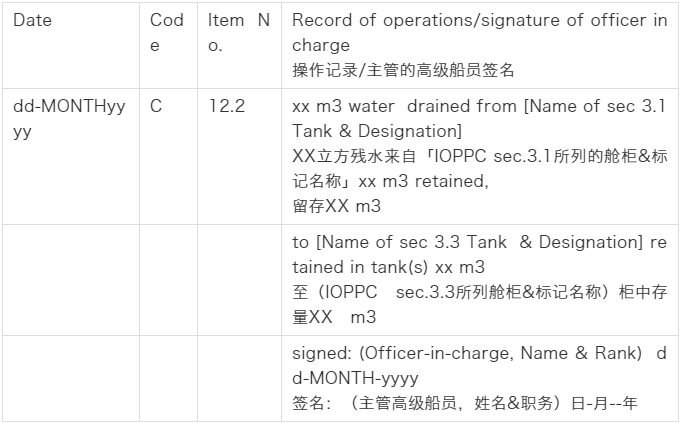
Note: Collection of bilge water need not to be accounted for, soonly one entry is required. Capacity of sludge tanks should not be recorded forC.12.x entries.
备注:收集舱底水操作无需说明,因此只需要污水存量记录.。油泥/油渣舱柜舱容不应做C.12.X项记录。
Example #5
Transfer from one oil residue (sludge) tank to another oil residue(sludge) tank, both listed under item 3.1 in the Supplement to the IOPP
在两个IOPP证书附录3.1所列油渣(泥)舱之间的调驳

Example #6
Incineration of oil residue (sludge) in Incinerator
焚烧炉内焚烧油渣(泥)
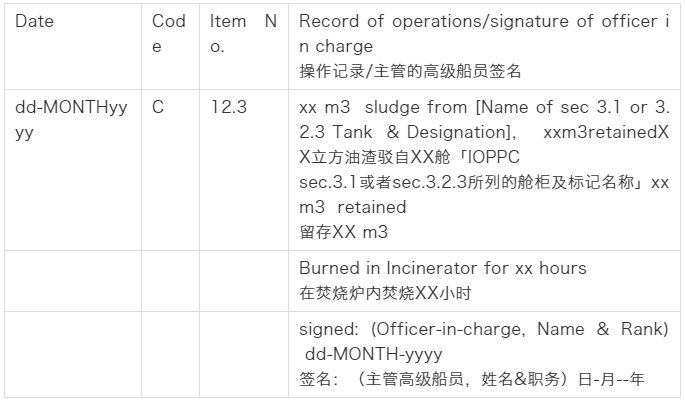
Example #7
Burning of oilresidue (sludge) in Boiler
锅炉内焚烧油渣

Example #8
Evaporation of water (disposal) from an oil residue (sludge) tanklisted under items 3.1 in the Supplement to the IOPPC
来自items 3.1所列油渣/泥舱柜水分蒸发(处理)
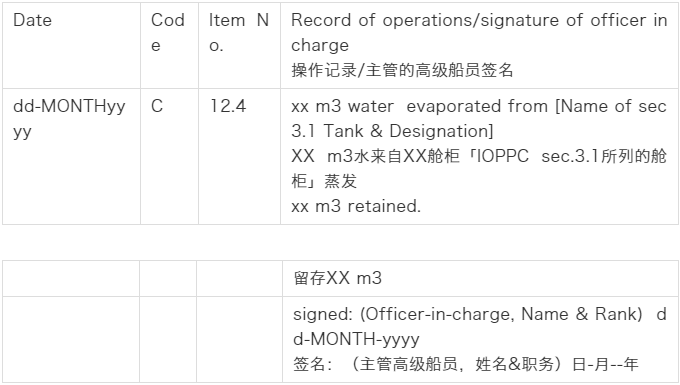
Example #9
Regeneration of fuel oil from oil residue (sludge)*
从油渣舱柜内再生的燃油(注意:只要我们IOPP证书明确列入的都应该叫油渣舱柜,现实中有很多人喜欢记录燃油泄放柜的油从新驳入沉淀柜使用作业。但有一点要注意,如果IOPP证书上在F.0 drin tank 后面有签注:比如Regenration /recovery,是可以记录的,如果没有此项签注,就最好不要记录了,可以记录转驳处理:12.2项)
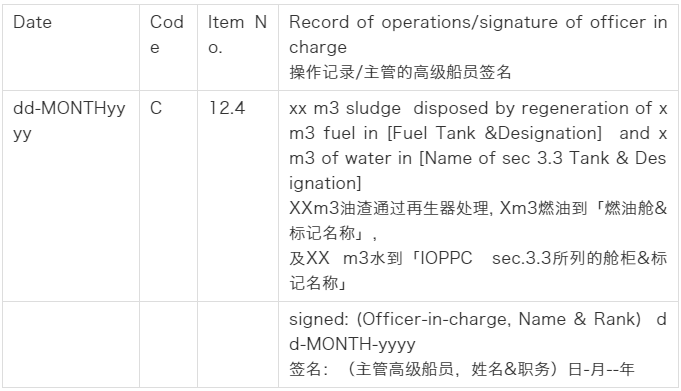
• OnlypermittedifmentionedasanapprovedmeansofdisposalintheIOPPCSupplement.
• 仅容许IOPP证书附录中认可的处理方式
Usage of code D: Non-automatic discharge overboard or disposalotherwise of bilge water which has accumulated in machinery spaces.
代码“D”的使用:机舱处所积存舱底水非自动排放或其他处理
Example #10
Pumping of bilge water from engine-room bilge wells to a tank listedunder item 3.3 in the Supplement to the IOPPC
驳运机舱污水井污水至IOPP证书附页3.3下所列舱柜

Example #11
Transfer of bilge water between tanks listed in item3.3 in the Supplement to the IOPPC
在IOPPC sec.3.3所列的舱柜间驳运污水

Example #12
Pumping of bilge water overboard from tank listed initem 3.3 in the Supplement to the
通过15ppm设备,处理IOPP证书附录3.3项所列舱柜中污水至舷外

Example #13
Disposal of bilge water from tank listed in item 3.3 in theSupplement to the IOPPC to oil residue (sludge) tank listed in item 3.1 in theSupplement to the IOPPC
处理IOPP证书附录 3.3项所列舱柜中污水到IOPP证书附录中3.1项所列油渣/泥舱柜(比如焚烧炉沉淀柜放下的污水)

Note: A code C.11.4 recording may berequired if this operation is a manual operator initiated operation.
备注:如果该项操作开始为人工操作,操作时可能要求记入代码“C11.4”项
Usage of code E: Automatic dischargeoverboard ,transfer or disposal otherwise of bilge water
which has accumulated inmachinery spaces.编码E的使用:机舱处所积存的舱底水自动排出舷外、转驳或其他处理
Example #14
Pumping of bilge water overboard via 15 ppm equipment from tanklisted in item 3.3 in the Supplement to the IOPPC or from engine-room bilgewells
通过15ppm装置j将来自IOPPC sec.3.3项所列舱柜或来自机舱污水井中污水排出舷外

Example #15
Transfer of bilge water from engine-room bilge wells to a tanklisted under item 3.3 in the Supplement to the IOPPC
驳运机舱污水井污水至IOPP证书附录3.3中所列舱柜
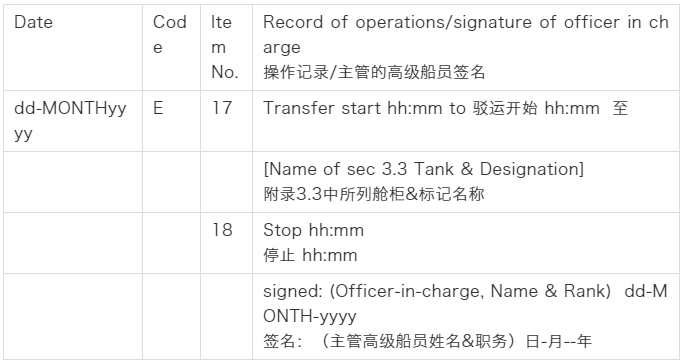
Usage of code F: Condition of oil filteringequipment
.编码F的用法:滤油设备状况
Example #16
Failure of OilyFiltering Equipment, Oil Content Meter or stopping device
滤油设备、油份计或停止装置故障

Note: The condition of the oil filteringequipment also covers the alarm and automatic
stoppingdevices, if applicable.滤油设备状况也包括报警设备及自动停止装置,如果适用
A code 'I' entry should also be made indicating that the overboardvalve was sealed shut due to non working Oil Filtering Equipment or Oil ContentMeter.
代码“I”项也应记录,表示由于滤油装置或油份计故障,排舷外阀的铅封
On the date where the system is functional again, a new entry, usingcode F 19 / 20 / 21 should be made where F 19 is the date and time of theinitial failure and F 20 is the time the system is functional again. 当系统恢复时应使用代码F19/20/21,F19记入系统故障日期及时间,F20记入系统恢复时间
Example #16bis
When properoperation of the Oily Filtering Equipment, Oil Content Meter or stopping deviceis restored
当滤油设备、油份计或自动停止装置恢复正常后

Note: The condition of the oil filtering equipment also covers thealarm and automatic stopping devices, if applicable.滤油设备状况也涵盖报警、自动停止装置,如果适用
A code 'I' entry should also be made indicating that the overboardvalve was sealed since the operation of the Oil Filtering Equipment or OilContent Meter has been restored
代码“I”项也应记录,表示由于滤油设备故障时排舷外阀的铅封
Usageof code G: Accidental or other exceptional discharges of oil.编码G的用法:意外或其他异常排油
Example #17 Accidental Pollution事故性污染
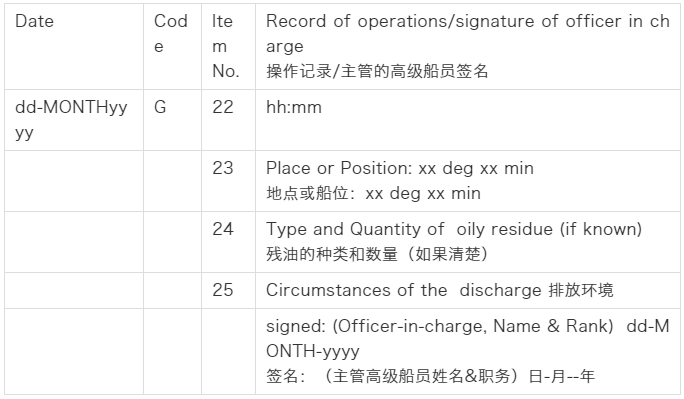
Note:IffailureofOilFilteringEquipmentorOilContentMeterrelatedequipmentisinvolved,appropriate(F) entry is to be made inORB.
如果与滤油设备或油份计故障有关系,油类记录簿中F项也应适当记录
Relevantsections of the SOPEP (SMPEP) are to be used to combat oil spills at sea.
启动“海上油污应急计划”SOPEP应对油污染
Examples ofCircumstances of discharge include, but are not limited to:排放环境包括但不限于
1.OilContentMeterfailure.油份计失效
2.Fueltankoverflow.燃油舱溢流
3.Rupturedbunkeringhose/flange.加油软管或法兰破损
4.Fueltankleakage(duetocollisionorgrounding).由于碰撞或搁浅引起的油舱柜泄露
Usage of code H:Bunkering of fuel or bulk lubricating oil.编码H的用法
Example #18 Bunkeringof Fuel oil燃油加装

Example #19
Bunkering of Bulk Lubricating oil
散供滑油加装

Note: Separate entries required for each grade of fuel oils andlubricating oils respectively to ensure transparency.加装不同级别的燃油和滑油应分别记录,确保操作透明
This entry isnot required if lubricating oils are delivered onboard in packaged form
(55 gallon drum,etc.).滑油如以包装好的形式供船(55加仑通等)则无需记录
Usage of code I:Additional operational procedures and general remarks.
编码”I”项使用:补充的作业程序和一般说明
Example #20
Pumping oily bilge water from a Cargo Hold bilge holding tank to atank listed under item 3.3 in the Supplement to the IOPP基本无此情况发生,如有,请示岸基主管
驳运货舱舱底水至IOPP证书附录3.3所列舱柜

Note: Any collection and transfer of oily bilge water into theengine-room bilge holding tank(s) from a cargo hold bilge holding tank(s)should be recorded using code (I)
所有从货舱污水舱收集含油污水驳至机舱污水舱应使用“I”记录
如果我们之前有项目忘记记录了,怎么办?
Example #21
Entry pertainingto an earlier missed operational entry
补记以前漏记项(以前进行了操作,忘记录入了,进行补记)
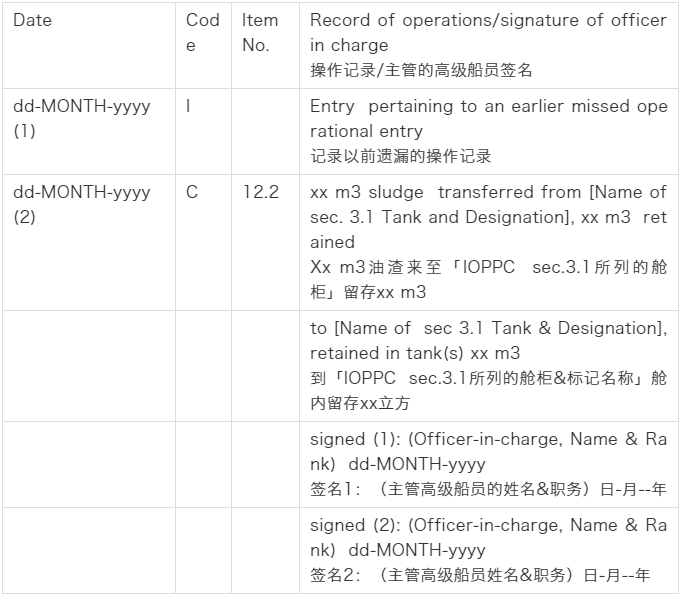
备注:Date(1) to be the initial date of operation.
日期(1)是当时操作日期
Date (2) to bethe current date i.e. the date the entry is made.
日期(2)当前日期,如记录当天日期 Signed (1) Signature of Officermaking I entry 签名(1)本次记录的船干签字
Signed (2)Signature of Officer making missed entry
签名(2)漏记人员签名
Example #22
De-bunkering of Fuel oil
卸/泵出燃油(发现船上燃油存在质量问题,无法使用,需驳回岸/他船处理,记录此项)
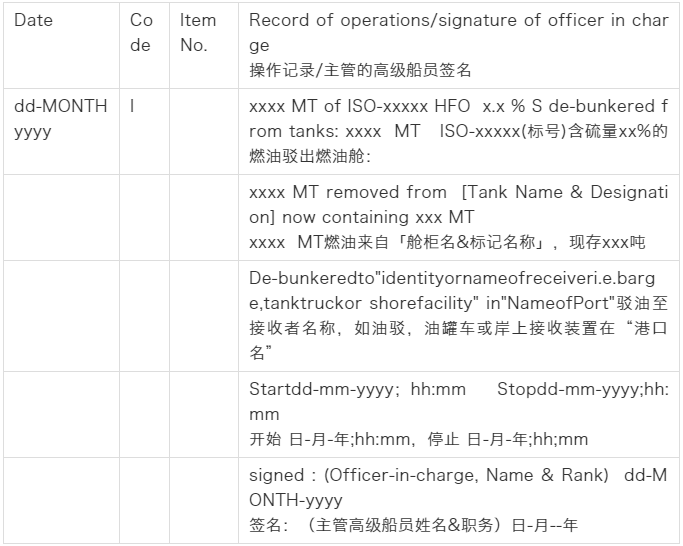
Note: Includereceipt & certificate from receiver for amount & type of fuel oilde-bunkered.
备注:包括来自接收方的收据或证明说明卸/泵出燃油的种类及数量
Tankers with sloptanks
有污油舱的油轮
Example #23
Transfer ofsludge from engine-room oil residue (sludge) tank to deck/cargo slop tank
从机舱残油(油渣)柜驳运机舱残油(油泥)至slop舱

Example #24
Transfer of bilge water from tank listed in item 3.3in the Supplement to the IOPPC to deck/cargo slop tank
驳运IOPP证书附录3.3中所列舱柜中舱底污水至SLOP舱

Note: Requiresthis method listed in the IOPP Supplement under item 3.2.3.
If non-oil-cargo related oily residues are transferred to slop tanksof oil tankers, the discharge of such residues should be in compliance withRegulation 34. (UI 22.1.1 for Regulation 15).Requires an entry in the OilRecord Book – Part II using code (J). If sludge or bilge water is transferred from multipletanks in engine-room a separate entry must be made in ORB Parts I & II foreach transfer
备注:IOPP附录第3.2 3. 列出了这种处理方式的要求
如果是与货油无关的油泥油渣驳入油轮的SLOP舱,排放这种油泥油渣满足REGULATION 34(R 35 UI22.11)
要求,需用编码”O”记入油类记录簿PART II中
如果是从机舱多只舱柜中将油泥或舱底水驳入SLOP舱,则应分别在ORB PART I &PART II分别记录每次驳运操作
General Guidance –Additional Voluntary Recordings
一般指南—附加的自愿记录(现在强制记录)
Example #25
Voluntary declaration of quantities retained in bilge water holdingtanks ref. MEPC.1/Circ.640 – record weekly
每周自愿填报MEPC.1/Circ.640中舱底水舱中存量

Example #26
Optional sealingof MARPOL Annex I related valve and/or equipment
可选的MARPOL Annex I相关阀门和/或设备铅封/封死

Example #27
Breaking ofoptional seal on MARPOL Annex I related valve and/or equipment
可选的与MARPOL Annex I相关的阀门和/或设备解除铅封/封闭
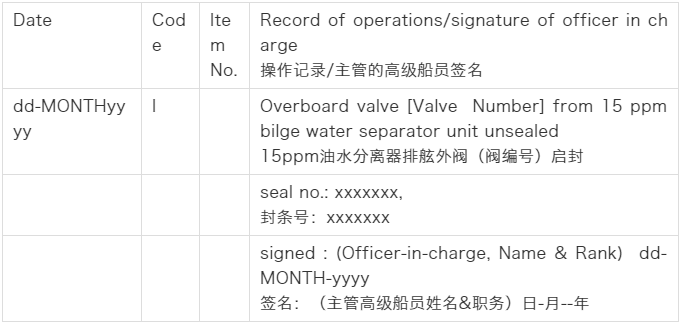
06-15 来源:信德海事
04-12 来源:信德海事网
07-17 来源:老郑 制造原理
05-08 来源:夏明华 苏玉马 世界海运
05-11 来源:信德海事网
10-29 来源: 龙de船人
06-18 来源:信德海事网
05-19 来源:海员之家
01-21 来源:信德海事网
09-25 来源:顾徐辉 信德海事